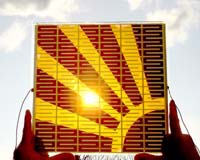 |
Washington DC (SPX) Nov 05, 2010 Extending its 26-year tradition of innovative quantum voltage standards, researchers at the National Institute of Standards and Technology (NIST) have begun shipping a new 10-volt standard to users around the world. The programmable system measures both direct current (DC) and alternating current (AC) voltages. NIST AC/DC 10-volt standard chip. The new 10-volt system* builds on a number of previous NIST inventions, from the initial 1-volt standard in 1984 through the 2006 unveiling of the world's first precision instrument for directly measuring AC voltages. Because the measurements are made using integrated circuits based on quantum phenomena and simple equations that can be reproduced reliably, NIST quantum voltage standards represent a major advance over historical artifact standards, which were essentially chemical batteries that were influenced by environmental conditions and sometimes drifted over time. About 50 standards labs, military organizations, and private companies worldwide calibrate voltmeters using standards based on earlier generations of NIST-developed technology. Products made with these instruments range from compact disc players to missile guidance systems. The new technology relies on superconducting integrated circuits containing about 300,000 Josephson junctions, whose quantum behavior ensures that every junction produces exactly the same voltage. Quantum voltage standards are based on the Josephson effect, observed when two superconducting materials are separated by a thin insulating or resistive film and a current tunnels through the barrier (or junction). When microwave radiation of a known frequency is applied, the junction generates a voltage that can be calculated based on that frequency and two fundamental constants of nature. The new standard offers unique advantages over previous generations. For DC metrology, benefits include higher immunity to noise (interference), output stability, and ease of system setup and operation. The system also enables a wider range of applications by producing AC waveforms for accurately calibrating AC signals with frequencies up to a few hundred hertz. A key advance is the use of junctions with metal-silicide barriers that produce stable steps and have uniform electrical properties. The system also incorporates new electronics, automation software, and measurement techniques. The first system was shipped to the Kennedy Space Center in Florida earlier this month, and others are on order by standards laboratories in Brazil and Taiwan. C.J. Burroughs, P.D. Dresselhaus, A. RUfenacht, D. Olaya, M.M. Elsbury, Y. Tang and S.P. Benz. "NIST 10 V programmable Josephson Voltage Standard System." Presented at the Conference on Precision Electromagnetic Measurements, Daejon, Korea, June 14, 2010.
Share This Article With Planet Earth
Related Links National Institute of Standards and Technology (NIST) Powering The World in the 21st Century at Energy-Daily.com
 Current Loss Tracked Down By Magnetic Fingerprint
Current Loss Tracked Down By Magnetic FingerprintBerlin, Germany (SPX) Nov 03, 2010 Scientists have been working on organic solar cells for about a decade. Their manufacture is environmentally friendly and they can be applied to all kinds of materials, such as plastic film, for instance. The trouble is, they only yield a fifth of the electrical energy that silicon solar cells do, with most of the electrical current trickling away into the material instead. Scientist ... read more |
|
| The content herein, unless otherwise known to be public domain, are Copyright 1995-2010 - SpaceDaily. AFP and UPI Wire Stories are copyright Agence France-Presse and United Press International. ESA Portal Reports are copyright European Space Agency. All NASA sourced material is public domain. Additional copyrights may apply in whole or part to other bona fide parties. Advertising does not imply endorsement,agreement or approval of any opinions, statements or information provided by SpaceDaily on any Web page published or hosted by SpaceDaily. Privacy Statement |